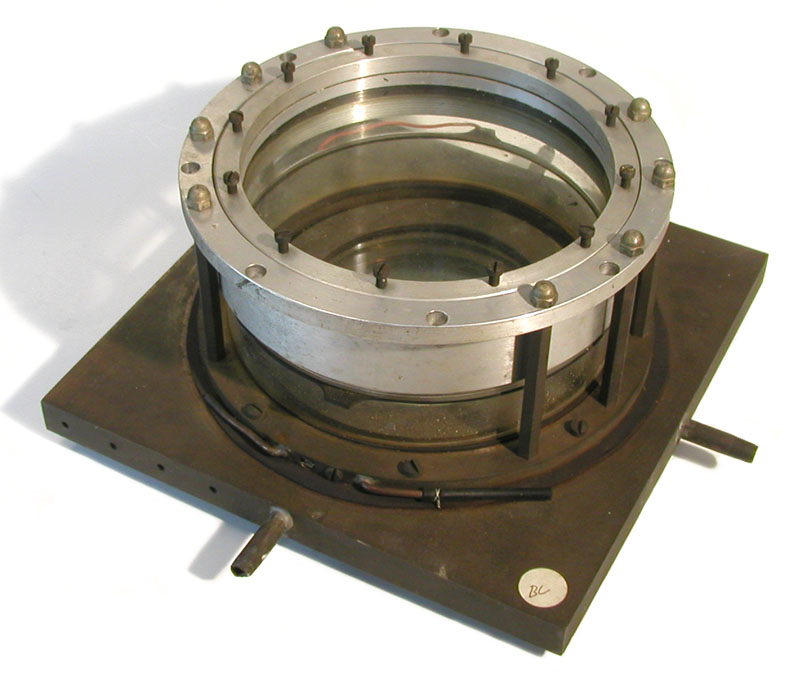Cloud Chamber of Carl Anderson (ca. 1935)

This wonderful item is a cloud chamber that was used by Carl Anderson and Seth Neddermeyer between 1935 and 1941 at Caltech. It served as the prototype for a larger (3 foot diameter) chamber that was carried in a B-29 aircraft from 1948 to 1950 to study cosmic rays at high altitudes. This particular chamber is unusual in that the piston is glass rather than metal. The advantage provided by the glass piston is that it allowed the chamber to be illuminated from below rather than from the side as in conventional designs.
Carl Anderson
Carl Anderson (1905-1991) received his PhD at the California Institute of Technology working under Robert Millikan. According to Anderson, Millikan never visited him once during his three years of graduate study. Anderson subsequently joined the Caltech faculty and remained there throughout his career.
He is best known for his discoveries of the positron (an antimatter electron) and the muon (the major component of cosmic rays), work for which he was awarded the Nobel Prize. These discoveries resulted from his idea of introducing a lead plate into the cloud chamber. His discovery of the positron in 1932 had a huge significance. Until then it had been believed that the only components of matter were electrons and protons. Dirac had "predicted" the antimatter electron, but he, and Anderson, had incorrectly assumed that the particle described by Dirac's equations was the proton. His discovery of the muon, a particle first believed to be a special type of electron, caused much consternation because it lost less energy passing through matter than quantum electrodynamic (QED) theory said it should. Faith in QED was restored when the muon was determined to be a completely new type of particle.
Seth Neddermeyer
Seth Neddermeyer was Carl Anderson's first graduate student at Caltech, and together with Anderson he co-discovered the muon in 1936. During WW II at Los Alamos, Neddermeyer conceived the idea of using focused explosives (implosion) to detonate the atomic weapon that employed plutonium as its fuel.
The Story of the Cloud Chamber
It was a fond recollection of the sunlight shining on tiny water droplets in the clouds swirling around the summit of Scotland’s Ben Nevis that spurred the attempts in 1895 of Charles Wilson, a young graduate student in J.J. Thompson’s Cambridge laboratory, to investigate cloud formation. The simple apparatus that Wilson constructed to duplicate Nature’s magic consisted of an air-filled cylinder the bottom of which was formed by the top of a piston. Rapidly drawing down the piston caused the chamber volume to expand. The resulting drop in the temperature of the saturated air lead to the formation of tiny liquid droplets. At the time, it was well known that airborne dust particles would serve as the condensation nuclei around which such tiny droplets would form. Much to his amazement however, Wilson’s investigations revealed that the droplets would form even in the absence of dust particles. This led him to propose that electrical charges must be spontaneously forming in the air and that these charges were acting as condensation nuclei.
At the same time that Wilson was mimicking cloud formation, J.J. Thompson was investigating the ionization of gases by Rontgen’s newly discovered X-rays. It was only natural therefore that Wilson should investigate the effect of introducing air that had been ionized by X-rays into the chamber. Just as Wilson expected, the X-rays greatly increased the number of condensation nuclei around which water droplets could form. While Wilson’s first “use” of the cloud chamber was to measure the charge of the ions that served as the condensation nuclei, its biggest impact would be that it permitted a visualization of the tracks of charged particles traveling through the gas.
In subsequent decades, the 1930s in particular, the cloud chamber proved to be an invaluable tool for investigating cosmic rays. A typical experimental setup consisted of the cloud chamber, a camera and a GM tube. The GM tube was used to detect the passage of a cosmic ray, trigger the expansion of the chamber, and activate the camera to record the tracks. Perhaps no one profited more from their use of the cloud chamber than Carl Anderson at Caltech.
Base: 10" x 10"
Chamber: ca. 6 1/4" diameter
Donated by the California Institute of Technology courtesy of Dr. "Bud" Cowan.
Reference
Bud Cowan. Personal communication.
